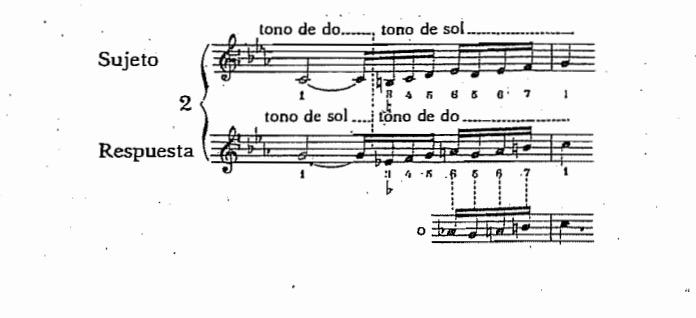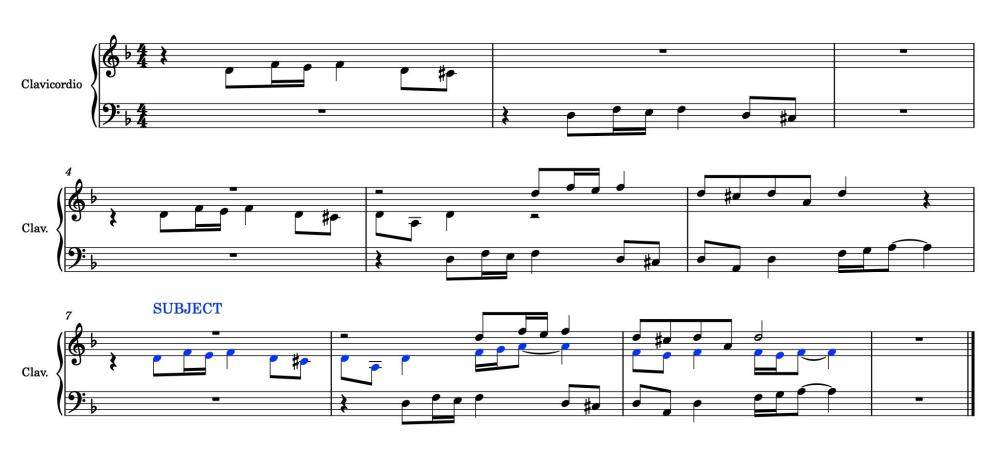Leaderboard
Popular Content
Showing content with the highest reputation on 07/22/2023 in all areas
-
Hi. You're right that subject is very flat. But the intention was to do something with that subject that is self-canonical and, truth be told, I didn't look for anything beyond that. I'm always on time, as I'm now making leaks. About the answer in F# minor (instead of major) I think there are two aspects to take into account: 1. that it is a matter of taste. Bach himself (he is the paradigm of the fugue to study although there are more composers!) in the fugue in C minor and the fugue in G minor referred to in the other thread starts the answer keeping the minor sonority and progressing to the dominant V major. For this chord is necessary at the end to return to the original key. 2. If we search in treatises we find the following. This image is from a very old treatise (André Gedalge) but it says that in minor keys the answer has the VI and VII degrees ascending in all cases, or when the scale is ascending (always). The image takes Cm as the base key. Therefore this answer can probably start with F#m sonority but it has to pass to major to return to Bm.2 points
-
@Guardian25 Hi, I don't understand your question very well: For Stretti is there a certain time interval before the stretto that is generally used? Or is it all dependent on the subject? Do you mean the time interval from when the first subject starts until the second subject starts and etc? If so, I think there is no fixed time interval. It can be very early, but also after two bars. What it has to be is that the subject overlaps BEFORE the first one ends. I made this little fugue to use that subject and make the stretti. I'm sure it has intervallic errors etc., but the truth is, although I try to observe them, in the end I let myself go by ear, and if it doesn't sound bad to me... I'll take it for good.2 points
-
This is my second completed piece as a beginner-intermediate composer. It has a Japanese anime feel to it. I enjoy listening to arrangements of anime music by Animenz (a piano YouTuber), and I wish I could learn more arrangement techniques and patterns. I apologize for the poor quality of the recording; I made a bunch of mistakes in it because I haven't practiced it well enough yet. It's still a draft, so there is definitely plenty of room for editing. I'd appreciate any suggestions, comments, or critiques! Thanks for listening.1 point
-
G'day Lets try this again. The general outline is below (Copied from r/rock and slightly modified) Post whatever you've been listening to lately, whether its a piece you've been listening to a lot, or a new piece you've discovered, it doesn't matter, post it. This is where you can post all requests and recommendations. If you're looking for a recommendation give a description/music link/composer so that other people will know what you want. Example: "I want to hear an composer that sounds like Tchaikovsky" (you can get more specific but this is usually enough) - and then hopefully someone will respond with recommendations X, Y, and Z. You can also leave a top level comment recommending an composer/school that you think others might like if they like X, Y, and Z. The more descriptive you guys are, the easier it is to help you find what you want. Just stating a composer's name isn't that helpful since you might only like one specific aspect of that composer's music.1 point
-
I've been listening and looking at the scores of Scarlatti's Sonatas This video has some of them 😛1 point
-
I'll Start. I've been mainly listening to Stravinky's Firebird Suite, particularly the Danse Infernale and Bercuse and Finale. And I've also been obsessing over Tchaikovsky's Romeo and Juliet Overture:1 point
-
I found this video on the topic, I hope this could help in some way for you!1 point
-
1 point
-
Wow, thanks for the live recording. Although the sound sounds analog, it's phenomenal. It's a great piece of work and with several sections, the important thing, for me, is that they flow absolutely well, even the first change into a waltz. Congratulations.1 point
-
@Henry Ng Tsz Kiu You know what? This is quite important: Yup for me cohesion is the most important thing in music, and transition is one of the hardest part to compose since it has to provide smooth and reasonable transitions between different parts. A very common mistake, and one that most of us have made, is that we want to write a big, important work..., and what we do is to put one section after another without any relation. In reality, almost all harmonic languages can be combined, but they need TRANSITIONS. It cannot be that after a section that sounds like a nineteenth-century waltz, comes something minimalist. It is an exaggeration, but I think it is understood. It takes a long time to learn that it is very important to invest effort in designing a work, as much as writing it. And well, I'm working on it... That's why I often prefer to keep the pieces short and not extend them without sense.1 point
-
Hey @Guardian25, Yeah I feel like it's more fluent and balanced now! Just two things, for b.28 I think the B flats can be changed to B naturals, and for b.42 I feel like the harmony can go to dominant G major first for a half cadenec before recapitulating the opening passage. Thx for update! Henry1 point
-
Hey Luis, For sure that final stretto in three parts is great and accurate. Maybe you add some modern touch here to have the line flowing in a more oblique eay as well. Maybe the answer should enter in F# minor instead of major? Henry1 point
-
Hello @yiminghuang47, Yup I enjoy the Japanese anime feeling here in terms of your melody, harmony and rhythm. It's very soothing to listen to. It's a good variation set when you vary the keys, texture and mood with different anime themes. I especially enjoy your modulations between the variations as they are very sensitive. The piano writing is clearly idiomatic as you play that out yourself. That's the most important thing! Our forum needs more of live recording! Much better than writing like Liszt but in real life they can't in their own right exist. Thx for sharing and joining! Also please feel free to check other members' posts and review them! Henry1 point
-
Hi everyone, just wanted to share a quick update on my previous post - I've found a composition teacher! I'm now studying with the one and only @Beethoven is God, who's been incredibly dedicated and helpful. Hope y'all are doing well 😉1 point
-
Indeed I rushed a lot in the 6/8 section, especially since the part is really difficult lol. Thanks for the feedback!1 point
-
I have updated the idea with the advice you gave! I think I like the recapitulation idea! I tried it in the updated version. What do you think?1 point
-
For Stretti is there a certain time interval before the stretto that is generally used? Or is it all dependent on the subject? Also, im liking this example, you should expand on it!1 point
-
Hello @Guardian25, I like this Baroque dance! It's indeed full of vivacity! For me the melody in b.27 strange. The Ab in RH for me should be A natural since in there the harmony is still in D minor or G minor for me. For b.32 after you have the V/F I suggest you add a bar for F minor harmony, before getting to E flat major in b.33 (or V/Eb there), since I think this will be more fluent! Also I feel like the ending on C minor is in a rush because you don't establish its return first and then you have the movement immediately ends on its return! I think you can have the first 8 bar recapitulates at the end, but this time it stays in C minor rather than modulate to Eb major. What do you think? Thx for sharing! Henry1 point
-
OK, I believe that with any subject, as I said before, you can find a solution to make a stretto, but sometimes, if you have not thought it through, it is difficult or limited to the first notes, or you can only make two superimpositions. Which is not bad either. I have read @Fermata 's method and it is very good, although I put here something simpler and useful for any subject. The idea is very simple: write, first of all, a subject that is canonical. Normally to the octave, but you can combine intervals. That is to say: we write a canon. Here I leave an example of how to build the canon to achieve three superimpositions (even if not at fixed times), to get the subject.1 point
-
No I really think you can definitely add stretti to any random subjects if the rules of counterpoints are not infringed. It's just whether the stretto is needed in the music or not and to decide whether to use it. As Fermata says there can be a type of stretto with the tails change to a free counterpoint, it can be easier to be made.1 point







